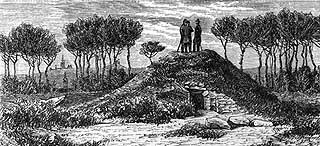- Home
- Megalithism in Morbihan
- Carnac
- Passage graves
- The Kercado dolmen
The dolmen is located in a private property but is open to the public. It stands on high ground overlooking Carnac, as the water tower situated nearby shows.
The monument was excavated in 1863 by R. Galles. Later, in 1925, it was studied again and restored by Z. Le Rouzic who remodelled its cairn and rather artificially raised the imposing menhir that today sits on top of it. The cairn is 40m in diameter and seems to be delimited by a wall-face.
It is surrounded by a wide enclosure consisting of 27 small menhirs, well preserved to the south.
Inside, the passage tomb is a single, quadrangular chamber (2.2 x 3.2m). The walling consists of 17 contiguous slabs; the passage is covered by five capstones and the chamber by a single one.
Two pillar stones of the passage, as well as the one marking the southern entrance of the chamber, bear a reticulated motif similar to that of Mané-Kerioned or Petit-Mont d'Arzon.
The northern jamb of the passage opening into the chamber no longer bears any sign of decoration but does take on the shape of an anthropomorphic figure which was probably roughly hewn in the stone. The ceiling of the chamber is adorned with a large "axe-plough" sign similar to that of the Locmariaquer steles. The outline of the capstone is unknown, but the unusual positioning of the sign suggests that the stone was probably re-used at some point in time.
The radiocarbon date given by charcoal collected at one of the excavations led by Z. Le Rouzic might correspond to an earlier period. Unfortunately, the dating (5200 to 4360 B.C.) is too imprecise to be of any real value.
The Kercado dolmen revealed a wealth of different artefacts, showing a succession of occupants; indeed, ancient items (notably 147 variscite beads) were found lying next to ceramics dating from the late Neolithic and the Bell Beaker period.
An early print showing the Kercado cairn.
Overall plan of the Kercado group : the passage grave in its cairn circled with menhirs.

